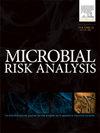Efficacy of machine learning models for the prediction of death occurrence and counts associated with foodborne illnesses and hospitalizations in the United States
IF 4
4区 环境科学与生态学
Q2 ENVIRONMENTAL SCIENCES
引用次数: 0
Abstract
Foodborne outbreak data released through national surveillance systems provides essential information about the results of investigations. This study evaluates the efficacy of machine learning (ML) models for the prediction of death occurrence and counts associated with foodborne illnesses and hospitalizations in the United States. Confirmed foodborne outbreaks were obtained from the Centers for Disease Control and Prevention's National Outbreak Reporting System (NORS). Foodborne pathogens causing at least 10 deaths in total were selected for analysis. The binary classification performance (accuracy, %) and prediction efficacy of ML models (mean absolute errors, MAE) were used for evaluation. A total of 10,069 foodborne outbreaks with confirmed single etiology resulted in 275,827 illnesses, 18,579 hospitalizations, and 458 deaths. Salmonella was the leading causative agent (54.23 %) of bacterial foodborne outbreaks, followed by pathogenic Escherichia coli (12.13 %). Norovirus (96.69 %) and Cyclospora cayetanensis (60.76 %) represented major causes of viral and protozoan/parasite foodborne outbreaks, respectively. The classification performance of ML models ranged from 88.9 to 94.5 % for the overall prediction of death occurrence associated with foodborne illnesses and hospitalizations. Prediction efficacy of ML models for death counts remained <0.9 with MAE, except for Listeria monocytogenes with an average MAE of 134.1 ± 11.1. This study indicates the potential use and performance of ML algorithms for the prediction of death occurrence or counts caused by foodborne etiological agents to improve public health safety based on the numbers of illnesses and hospitalizations.

机器学习模型在美国预测与食源性疾病和住院相关的死亡发生率和计数的有效性
通过国家监测系统发布的食源性暴发数据提供了有关调查结果的基本信息。本研究评估了机器学习(ML)模型在预测美国与食源性疾病和住院相关的死亡发生率和计数方面的功效。确认的食源性暴发是从疾病控制和预防中心的国家暴发报告系统(NORS)获得的。选择了总共至少造成10人死亡的食源性病原体进行分析。采用二元分类性能(准确率,%)和ML模型的预测效果(平均绝对误差,MAE)进行评价。经确认的单一病因食源性暴发共发生10069起,导致275827人患病,18579人住院,458人死亡。沙门氏菌是食源性细菌暴发的主要病原菌(54.23%),其次是致病性大肠杆菌(12.13%)。诺如病毒(96.69%)和卡耶坦环孢子虫(60.76%)分别是病毒和原虫/寄生虫食源性暴发的主要原因。ML模型在预测与食源性疾病和住院相关的死亡发生率方面的分类性能从88.9%到94.5%不等。ML模型对死亡计数的MAE预测效率为<;0.9,但单核增生李斯特菌的平均MAE为134.1±11.1。本研究表明ML算法的潜在用途和性能,用于预测食源性病原体引起的死亡发生或计数,以改善基于疾病和住院人数的公共卫生安全。
本文章由计算机程序翻译,如有差异,请以英文原文为准。
求助全文
约1分钟内获得全文
求助全文
来源期刊

Microbial Risk Analysis
Medicine-Microbiology (medical)
CiteScore
5.70
自引率
7.10%
发文量
28
审稿时长
52 days
期刊介绍:
The journal Microbial Risk Analysis accepts articles dealing with the study of risk analysis applied to microbial hazards. Manuscripts should at least cover any of the components of risk assessment (risk characterization, exposure assessment, etc.), risk management and/or risk communication in any microbiology field (clinical, environmental, food, veterinary, etc.). This journal also accepts article dealing with predictive microbiology, quantitative microbial ecology, mathematical modeling, risk studies applied to microbial ecology, quantitative microbiology for epidemiological studies, statistical methods applied to microbiology, and laws and regulatory policies aimed at lessening the risk of microbial hazards. Work focusing on risk studies of viruses, parasites, microbial toxins, antimicrobial resistant organisms, genetically modified organisms (GMOs), and recombinant DNA products are also acceptable.
 求助内容:
求助内容: 应助结果提醒方式:
应助结果提醒方式:


